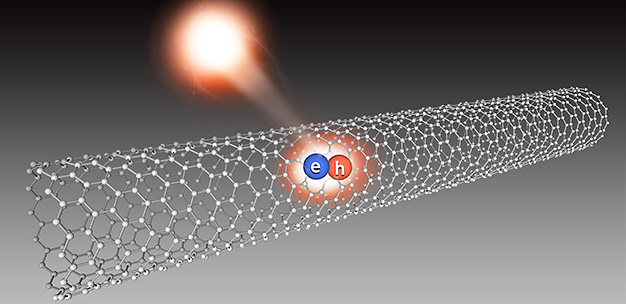Carbon nanotubes that emit single photons at telecommunication wavelengths and room temperature could be useful for quantum cryptography
Published online 9 July 2015

When the electron (e) and hole (h) of an exciton recombine in a single-walled carbon nanotube they produce a single photon.
© 2015 Hideyuki Maki, Keio University
Single-walled carbon nanotubes can emit single photons at room temperature and at wavelengths used for telecommunications, according to research by Keio University scientists1. This makes them very attractive as single-photon sources for quantum cryptography systems.
Quantum cryptography is an emerging technology that uses the quantum-mechanical properties of photons to encrypt information. The laws of quantum mechanics ensure that any attempt to intercept the information would garble it. For quantum cryptography to become commercially viable, light sources are required that produce just one photon at a time and at wavelengths used for telecommunications.
Takumi Endo, Junko Ishi-Hayase and Hideyuki Maki at Keio University have discovered that single-walled carbon nanotubes meet both criteria with an unexpected bonus ― they generate single photons at room temperature.
"We expected that single-walled carbon nanotubes would be suitable materials for single-photon sources at telecommunication wavelengths," says Maki, who led the research. "But we were very surprised that they produced single photons at room temperature."
The researchers used a superconducting single-photon detector to measure and analyze the light emitted from the nanotubes for temperatures from 6 to 300 kelvin (room temperature). The results revealed that the nanotubes exhibited 'photon antibunching' over the full temperature range ― a sure indicator that they were emitting single photons.
Single-walled carbon nanotubes contain quasiparticles called excitons that consist of a negative electron and a positive hole. In the case of 'localized' excitons (that is, those restricted to a narrow area), a single photon of light is emitted when the electron fills the hole in a process called recombination (see image). Localized excitons tend to become non-localized with increasing temperature, making it less likely that single-photon emission will occur. The scientists suspect, however, that a sleeve of randomly arranged carbon atoms on the nanotube shields it from direct contact with air, which allows the localized excitons to exist at high temperatures. This means that the nanotube's optical properties could potentially be fine-tuned using external coatings, for example.
A further advantage of these nanotubes is that they can be readily incorporated on silicon chips. "Since single-walled carbon nanotubes can be directly grown on silicon chips, nanotube-based emitters can be easily combined with silicon photonics," notes Maki. This, together with the fact that the nanotubes do not require cooling, makes on-chip single-photon sources a feasible proposition ― something that would greatly facilitate widespread uptake of quantum cryptography.
The researchers intend to improve the efficiency of single-photon generation by nanotubes and apply a nanotube-based single-photon source to current quantum cryptography technology.
Reference
- Endo, T., Ishi-Hayase, J. & Maki, H. Photon antibunching in single-walled carbon nanotubes at telecommunication wavelengths and room temperature. Applied Physics Letters 106, 113106 (2015). | article